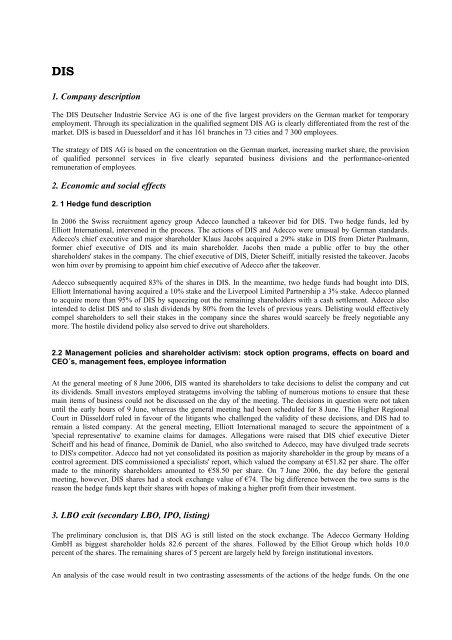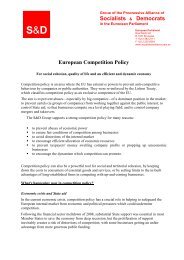Executive summary - Udo Bullmann
Executive summary - Udo Bullmann
Executive summary - Udo Bullmann
- No tags were found...
Create successful ePaper yourself
Turn your PDF publications into a flip-book with our unique Google optimized e-Paper software.
DIS1. Company descriptionThe DIS Deutscher Industrie Service AG is one of the five largest providers on the German market for temporaryemployment. Through its specialization in the qualified segment DIS AG is clearly differentiated from the rest of themarket. DIS is based in Duesseldorf and it has 161 branches in 73 cities and 7 300 employees.The strategy of DIS AG is based on the concentration on the German market, increasing market share, the provisionof qualified personnel services in five clearly separated business divisions and the performance-orientedremuneration of employees.2. Economic and social effects2. 1 Hedge fund descriptionIn 2006 the Swiss recruitment agency group Adecco launched a takeover bid for DIS. Two hedge funds, led byElliott International, intervened in the process. The actions of DIS and Adecco were unusual by German standards.Adecco's chief executive and major shareholder Klaus Jacobs acquired a 29% stake in DIS from Dieter Paulmann,former chief executive of DIS and its main shareholder. Jacobs then made a public offer to buy the othershareholders' stakes in the company. The chief executive of DIS, Dieter Scheiff, initially resisted the takeover. Jacobswon him over by promising to appoint him chief executive of Adecco after the takeover.Adecco subsequently acquired 83% of the shares in DIS. In the meantime, two hedge funds had bought into DIS,Elliott International having acquired a 10% stake and the Liverpool Limited Partnership a 3% stake. Adecco plannedto acquire more than 95% of DIS by squeezing out the remaining shareholders with a cash settlement. Adecco alsointended to delist DIS and to slash dividends by 80% from the levels of previous years. Delisting would effectivelycompel shareholders to sell their stakes in the company since the shares would scarcely be freely negotiable anymore. The hostile dividend policy also served to drive out shareholders.2.2 Management policies and shareholder activism: stock option programs, effects on board andCEO´s, management fees, employee informationAt the general meeting of 8 June 2006, DIS wanted its shareholders to take decisions to delist the company and cutits dividends. Small investors employed stratagems involving the tabling of numerous motions to ensure that thesemain items of business could not be discussed on the day of the meeting. The decisions in question were not takenuntil the early hours of 9 June, whereas the general meeting had been scheduled for 8 June. The Higher RegionalCourt in Düsseldorf ruled in favour of the litigants who challenged the validity of these decisions, and DIS had toremain a listed company. At the general meeting, Elliott International managed to secure the appointment of a'special representative' to examine claims for damages. Allegations were raised that DIS chief executive DieterScheiff and his head of finance, Dominik de Daniel, who also switched to Adecco, may have divulged trade secretsto DIS's competitor. Adecco had not yet consolidated its position as majority shareholder in the group by means of acontrol agreement. DIS commissioned a specialists' report, which valued the company at €51.82 per share. The offermade to the minority shareholders amounted to €58.50 per share. On 7 June 2006, the day before the generalmeeting, however, DIS shares had a stock exchange value of €74. The big difference between the two sums is thereason the hedge funds kept their shares with hopes of making a higher profit from their investment.3. LBO exit (secondary LBO, IPO, listing)The preliminary conclusion is, that DIS AG is still listed on the stock exchange. The Adecco Germany HoldingGmbH as biggest shareholder holds 82.6 percent of the shares. Followed by the Elliot Group which holds 10.0percent of the shares. The remaining shares of 5 percent are largely held by foreign institutional investors.An analysis of the case would result in two contrasting assessments of the actions of the hedge funds. On the one





